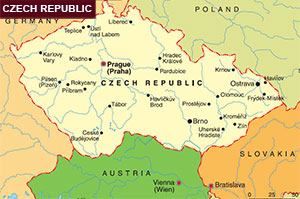Pharmacoeconomic Guidelines: Czech Republic
Country/Region: Czech Republic

Submission Guidelines
Cost-effectiveness Guidelines (May 2017) and Budget Impact Guidelinies published by State Institute for Drug Control (SUKL) (Czech official HTA agency for drug regulation)
Submission Guidelines Source:
Cost-effectiveness guidelines
PDF in Czech
Budget impact guidelines
PDF in Czech
Additional Information:
Health economics guidelines (cost-effectiveness and budget impact) in Czech Republic by Czech Pharmacoeconomic Society (CFES, May 2020) https://farmakoekonomika.cz/2020-doporucene-postupy-pro-zdravotne-ekonomicka-hodnoceni-v-cr-ceska-spolecnost-pro-farmakoekonomiku-a-hodnoceni-zdravotnickych-technologii-cfes/
Information current as of Wednesday, October 19, 2022
Key Features
| Key Features | |
|---|---|
| Type of Guidelines | Submission Guidelines |
| Title and year of the document | Cost-effectiveness Guidelines (May 2017) and CFES GL - May 2020 |
| Affiliation of authors | State Institute for Drug Control (http://www.sukl.eu/) |
| Purpose of the document | To establish both methodology and ideal modelling instruments for the assessment of cost-effectiveness and budget impact analyses submitted to SUKL |
| Standard reporting format included | Yes, the report should consist of generally recommended chapters (i.e. purpose of the study, comparator, target population, perspective, clinical inputs, costing etc.) |
| Disclosure | Yes, however some parts of the dossier can be classified as confidential except the main results of clinical evidence and the pharmacoeconomic evaluation (i.e. ICER, net budget impact) |
| Target audience of funding/ author's interests | State Institute of Drug Control and Health insurance companies |
| Perspective | Public healthcare system (i.e. health insurance companies) and societal perspective for Orphan medicines as of January 2022 |
| Indication | Yes. Detailed indication criteria following pivotal randomized clinical trial should be included (not as stated in summary of product characteristics). Indication criteria have to be in line with target population in the pharmacoeconomic model. |
| Target population | Target population must be clearly described and be fully in line with the terms of reimbursement/indication criteria |
| Subgroup analysis | Yes, if it is meaningful, possible to construct and makes it statistical sense. |
| Choice of comparator | Therapeutic procedures that are accepted as commonly used in the target population and, at the same time, are currently permanently (not temporarily or exceptionally) covered/reimbursed by health insurance companies |
| Time horizon | The time horizon should be long enough to allow a reliable and reasonable conclusions of the difference in costs and health benefits/outcomes (QALYs) based on available evidence |
| Assumptions required | Yes |
| Preferred analytical technique | Cost-utility analysis (CUA) with QALY as final outcome measure is preferred. In some justified cases (non-inferiority/superiority), cost-minimization (CMA) can be used. If QALY is not possible to estimate, reasonable surrogate outcomes (such as life-years (LY)) can be used in CEA. |
| Costs to be included | All relevant direct costs covered from health insurance companies perspective (medical and non-medical) to the disease should be identified and indirect/ productivity costs, in case of societal perspective for orphans. |
| Source of costs | List of Reimbursed medicinal products (www.sukl.eu), Current version of Regulation No. 134/1998 Coll. and decree setting out the list of medical services (reimbursement + restrictions), official list of reimbursed medical devices (published by Health insurance companies) and list of DRG |
| Modeling | Yes |
| Systematic review of evidences | Yes |
| Preference for effectiveness over efficacy | Yes, if the study is robust and quality. |
| Preferred outcome measure | Quality-adjusted life-year (QALY) is preffered outcomes. In cases where this outcome is not possible to use, life-years gained (LYG) or other surrogate outcomes can be used |
| Preferred method to derive utility | EQ-5D or specific questionnaire that can be converted into EQ-5D by a mapping algorithm. If EQ-5D is not available, other sources can be used but have to be discussed. |
| Equity issues stated | No |
| Discounting costs | Basecase: 3%; Sensitivity analysis: 0% and 5% |
| Discounting outcomes | Basecase: 3%; Sensitivity analysis: 0% and 5% |
| Sensitivity analysis-parameters and range | Sensitivity analysis should include all input parameters and estimate their impact on basecase result. Ranges should be based on standard errors (SE) or 95% confidence intervals. If assumptions about ranges are made (e.g. ±20%), these have to be justified and discussed. |
| Sensitivity analysis-methods | One-way sensitivity analysis (OWSA), scenario analysis and probabilistic sensitivity analysis (PSA) |
| Presenting results | OWSA: Table or tornado diagramme, PSA: Cost-effectiveness plane/scatter plot, cost-effectiveness acceptability curve (CEAC) with probability that an intervention is cost-effective at given willignness to pay threshold (WTP; equal to 1,2 million CZK (approx. €47000/QALY) |
| Incremental analysis | Yes |
| Total costs vs effectiveness (cost/effectiveness ratio) | Yes |
| Portability of results (Generalizability) | Only for Czech Republic |
| Financial impact analysis | Yes. These include detailed estimation of the number of treated patients (based on required indication criteria) and consequent costs (drug costs but also others - complications, costly procedures etc.) |
| Mandatory or recommended or voluntary | Mandatory by Law (both cost-effectiveness and budget/financial impact analysis) |
Acknowledgement: